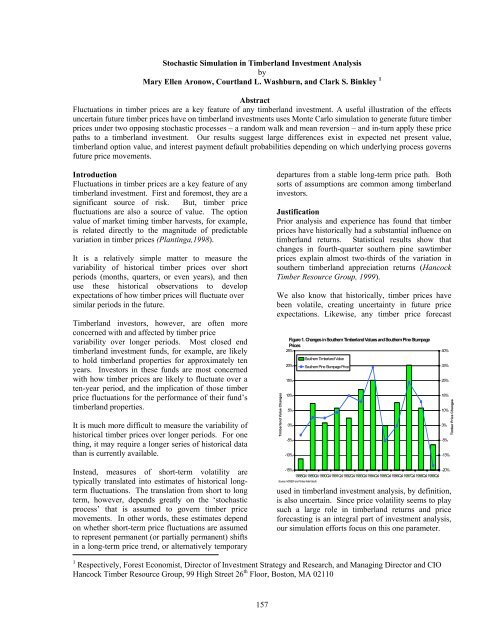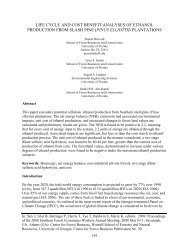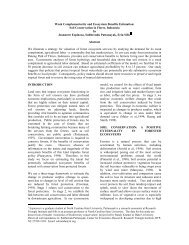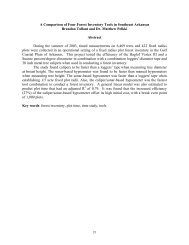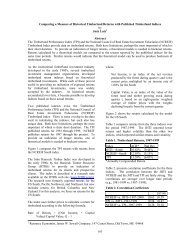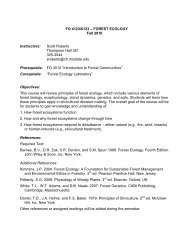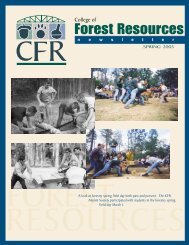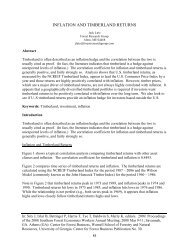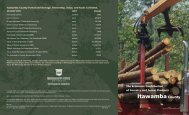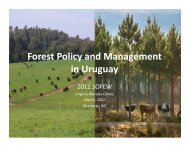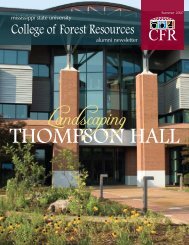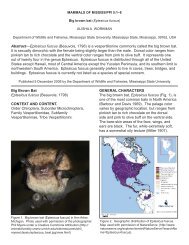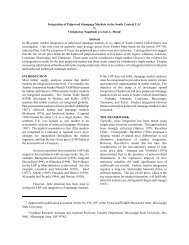Stochastic Simulation in Timberland Investment Analysis - sofew
Stochastic Simulation in Timberland Investment Analysis - sofew
Stochastic Simulation in Timberland Investment Analysis - sofew
You also want an ePaper? Increase the reach of your titles
YUMPU automatically turns print PDFs into web optimized ePapers that Google loves.
<strong>Stochastic</strong> <strong>Simulation</strong> <strong>in</strong> <strong>Timberland</strong> <strong>Investment</strong> <strong>Analysis</strong>byMary Ellen Aronow, Courtland L. Washburn, and Clark S. B<strong>in</strong>kley 1AbstractFluctuations <strong>in</strong> timber prices are a key feature of any timberland <strong>in</strong>vestment. A useful illustration of the effectsuncerta<strong>in</strong> future timber prices have on timberland <strong>in</strong>vestments uses Monte Carlo simulation to generate future timberprices under two oppos<strong>in</strong>g stochastic processes – a random walk and mean reversion – and <strong>in</strong>-turn apply these pricepaths to a timberland <strong>in</strong>vestment. Our results suggest large differences exist <strong>in</strong> expected net present value,timberland option value, and <strong>in</strong>terest payment default probabilities depend<strong>in</strong>g on which underly<strong>in</strong>g process governsfuture price movements.IntroductionFluctuations <strong>in</strong> timber prices are a key feature of anytimberland <strong>in</strong>vestment. First and foremost, they are asignificant source of risk. But, timber pricefluctuations are also a source of value. The optionvalue of market tim<strong>in</strong>g timber harvests, for example,is related directly to the magnitude of predictablevariation <strong>in</strong> timber prices (Plant<strong>in</strong>ga,1998).It is a relatively simple matter to measure thevariability of historical timber prices over shortperiods (months, quarters, or even years), and thenuse these historical observations to developexpectations of how timber prices will fluctuate oversimilar periods <strong>in</strong> the future.<strong>Timberland</strong> <strong>in</strong>vestors, however, are often moreconcerned with and affected by timber pricevariability over longer periods. Most closed endtimberland <strong>in</strong>vestment funds, for example, are likelyto hold timberland properties for approximately tenyears. Investors <strong>in</strong> these funds are most concernedwith how timber prices are likely to fluctuate over aten-year period, and the implication of those timberprice fluctuations for the performance of their fund’stimberland properties.It is much more difficult to measure the variability ofhistorical timber prices over longer periods. For oneth<strong>in</strong>g, it may require a longer series of historical datathan is currently available.Instead, measures of short-term volatility aretypically translated <strong>in</strong>to estimates of historical longtermfluctuations. The translation from short to longterm, however, depends greatly on the ‘stochasticprocess’ that is assumed to govern timber pricemovements. In other words, these estimates dependon whether short-term price fluctuations are assumedto represent permanent (or partially permanent) shifts<strong>in</strong> a long-term price trend, or alternatively temporarydepartures from a stable long-term price path. Bothsorts of assumptions are common among timberland<strong>in</strong>vestors.JustificationPrior analysis and experience has found that timberprices have historically had a substantial <strong>in</strong>fluence ontimberland returns. Statistical results show thatchanges <strong>in</strong> fourth-quarter southern p<strong>in</strong>e sawtimberprices expla<strong>in</strong> almost two-thirds of the variation <strong>in</strong>southern timberland appreciation returns (HancockTimber Resource Group, 1999).We also know that historically, timber prices havebeen volatile, creat<strong>in</strong>g uncerta<strong>in</strong>ty <strong>in</strong> future priceexpectations. Likewise, any timber price forecast<strong>Timberland</strong> Value ChangesFigure 1. Changes <strong>in</strong> Southern <strong>Timberland</strong> Values and Southern P<strong>in</strong>e StumpagePrices25%20%15%10%5%0%-5%-10%-15%-20%1988Q41989Q41990Q41991Q41992Q41993Q41994Q41995Q41996Q41997Q41998Q41999Q4Source: NCREIF and Timber Mart-SouthSouthern <strong>Timberland</strong> ValueSouthern P<strong>in</strong>e Stumpage Priceused <strong>in</strong> timberland <strong>in</strong>vestment analysis, by def<strong>in</strong>ition,is also uncerta<strong>in</strong>. S<strong>in</strong>ce price volatility seems to playsuch a large role <strong>in</strong> timberland returns and priceforecast<strong>in</strong>g is an <strong>in</strong>tegral part of <strong>in</strong>vestment analysis,our simulation efforts focus on this one parameter.40%33%25%18%10%3%-5%-13%Timber Price Changes1 Respectively, Forest Economist, Director of <strong>Investment</strong> Strategy and Research, and Manag<strong>in</strong>g Director and CIOHancock Timber Resource Group, 99 High Street 26 th Floor, Boston, MA 02110157
BackgroundJust as we do not know mean levels or volatility’s offuture timber prices, we also do not know theunderly<strong>in</strong>g stochastic process that determ<strong>in</strong>e thesefuture prices. When posed with the question of howto model the underly<strong>in</strong>g price process, we turn to theacademic literature which proffers two ma<strong>in</strong>approaches, mean reversion and the random walk(Brazee and Mendelson, 1988, Haight and Holmes,1991, Hultkrantz, 1993, Washburn and B<strong>in</strong>kley,1990, Y<strong>in</strong> and Newman, 1996).Simply stated, nonstationary processes or the randomwalk for time series data implies all <strong>in</strong>formation toforecast a future price is housed <strong>in</strong> the current price.One could further say, there is noth<strong>in</strong>g to ga<strong>in</strong> fromanalyz<strong>in</strong>g past prices – for they do not help predictfuture prices.Stationary processes or mean reversion on the otherhand, produce future timber price paths that fluctuatearound the mean of the historical series. If a futureperiod’s price departs from the mean, a movement <strong>in</strong>the opposite direction <strong>in</strong> a subsequent period correctsit. One could argue then, that f<strong>in</strong>ancial ga<strong>in</strong>s couldbe realized by exploit<strong>in</strong>g the underly<strong>in</strong>g stochasticprocess, for past prices can be used to predict futureprices (Brazee and Mendelsohn 1988, Lohmander1988).MethodologyIn this analysis we simulate future timber pricesunder both underly<strong>in</strong>g price processes (the randomwalk and mean reversion) and <strong>in</strong> turn evaluate thef<strong>in</strong>ancial performance of a model forest under each.The two price processes can be expressed as:Random Walk: ln(P t ) = r + ln(P t-1 ) + twhere ~ N(0, 9)r = rate of driftMean Reversion: ln(Pt) = rt + ln(Po) + where ~ N(0,9)r = rate of driftOur model forest consists of a fully regulatedsouthern p<strong>in</strong>e plantation <strong>in</strong> the South; imply<strong>in</strong>g equalvolumes of timber are harvested each year. Timberprice statistics used <strong>in</strong> the model are based on TimberMart-South’s Alabama statewide average stumpageprices, adjusted for <strong>in</strong>flation.Current Price StandardDeviationsawtimber $48.07/ton 16.2%chip-n-saw $34.95/ton 12.0%pulpwood $ 8.27/ton 12.3%The model ma<strong>in</strong>ta<strong>in</strong>s the historical correlationbetween products – not allow<strong>in</strong>g one price to out-stepanother overtime. We base this relationship on theproduct prices over the period 1981 to 2000.Correlation Matrixsawtimber chip-n-saw pulpwoodsawtimber 1.00chip-n-saw 0.70 1.00pulpwood 0.47 0.52 1.00F<strong>in</strong>ancial performance is structured <strong>in</strong> real (<strong>in</strong>flationadjusted)terms. The annual management and capitalcosts comb<strong>in</strong>ed are $20 per acre, assumed to beconstant through time. Our expectations of futuretimber prices used <strong>in</strong> the model assume zero realprice appreciation.The asset value model is calculated such that:Asset Value = (<strong>in</strong>come t + <strong>in</strong>come t-1 + <strong>in</strong>come t-2 ) / awhere: a = <strong>in</strong>come capitalization rateOur experience shows that generally, timberlandvalues do not immediately follow cash flows. In fact,timberland values seem to lag <strong>in</strong>come streams.Therefore, the current asset value used <strong>in</strong> the modelis calculated as a roll<strong>in</strong>g three-year average of<strong>in</strong>come from the property, capitalized at 8.0 percent.<strong>Simulation</strong>We generate 50,000 computer simulations of timberprices over a ten-year period us<strong>in</strong>g Monte Carlosimulation – a process of draw<strong>in</strong>g random numbersfrom a specified probability distribution – to measurethe effects of uncerta<strong>in</strong>ty <strong>in</strong> future prices under eachprice process.Figure 2 and 3 illustrate southern p<strong>in</strong>e sawtimberstumpage price paths under a random walk and meanreversion. The expected price is $48.07 per ton withan expected annual standard deviation of 16.2percent. At year ten, the variability around theexpected price differs widely depend<strong>in</strong>g on theunderly<strong>in</strong>g price process.Figure 2 charts the simulated price paths under arandom walk process. At year ten, the median price is$48.07 yet the mean price generated is $54.98, with astandard deviation of $30.43.158
70%60%50%Figure 5. Probability of Interest Payment Default under a Random WalkCoverage Ratio = 1Coverage Ratio = 1.5Coverage Ratio = 2<strong>in</strong>vestor can put back the property to the seller <strong>in</strong> tenyears for the amount of the orig<strong>in</strong>al purchase price($979 per acre) at some cost. What is the cost of theoption given a random walk assumption or a meanreversion assumption?The horizontal axis on both Figures 7 and 8 show theFigure 7. Value of a <strong>Timberland</strong> Put Option under a Random WalkPercentage40%30%3.0%2.5%20%2.0%10%0%1 2 3 4 5 6 7 8 9 10yearsUnder a coverage ratio of 1.5, mean<strong>in</strong>g the lenderrequires you to have a cash flow equal to 1.5 timesyour <strong>in</strong>terest payment or you are <strong>in</strong> default, theprobability of default at the onset of the <strong>in</strong>vestmentunder a random walk is about 5 percent. Even though<strong>in</strong>flation-adjusted payments are decreas<strong>in</strong>g throughtime, the probability of default rises by the tenth yearof the <strong>in</strong>vestment to 13 percent.Figure 6. Probability of Interest Payment Default under a Mean Reversion70%Probability1.5%1.0%0.5%0.0%2.5 47.592.5 138 183 228 273 318 363 408 453 498 543 588 633 678 723 768 813 858 903 948 993Proceeds from Exercis<strong>in</strong>g Put at Year 10 ($/acre)proceeds of exercis<strong>in</strong>g the option at year ten. Thevertical axis charts the probability of receiv<strong>in</strong>g theproceeds. Suppose the timberland asset value fell to$500 per acre <strong>in</strong> year ten. The <strong>in</strong>vestor wouldexercise the put option and the proceeds <strong>in</strong> do<strong>in</strong>g soare $479 per acre (the orig<strong>in</strong>al $979 per acre m<strong>in</strong>usthe current asset value of $500 per acre).60%50%Coverage Ratio = 1Coverage Ratio = 1.5Coverage Ratio = 2The probability assigned to the event of the assetvalue dropp<strong>in</strong>g to $500 per acre varies depend<strong>in</strong>g onthe underly<strong>in</strong>g timber price process.Percentage40%30%20%10%0%1 2 3 4 5 6 7 8 9 10yearsIf a mean reversion process governs future prices,your default probability is aga<strong>in</strong> five percent at yearone of the <strong>in</strong>vestment – yet your risk of default atyear ten falls to zero.Our last application looks at how the underly<strong>in</strong>g priceprocess affects the value of a timberland ‘put option’.To mitigate the risk of low future timberland values,an <strong>in</strong>vestor may look for downside protection <strong>in</strong> theform of an option to ‘put back’ the property to theseller for some specified price at some period <strong>in</strong> time.In our example, we assume both parties agree that theUnder a random walk assumption, the probability ofthe asset value fall<strong>in</strong>g to $500 – <strong>in</strong> other words, theprobability of receiv<strong>in</strong>g the $479 <strong>in</strong> proceeds - is0.35 percent. In contrast, Figure 8 shows theprobability of receiv<strong>in</strong>g the $479 <strong>in</strong> proceeds fromexercis<strong>in</strong>g the put option under a mean reversionprocess to be 0.001 percent.We can further calculate a probability-weighted NPVof the put option to see how the <strong>in</strong>itial price processassumption can greatly alter <strong>in</strong>vestment decisions.Under a random walk, the probability-weighted costof the option is $55.72 per acre (us<strong>in</strong>g an 8.0 percentdiscount rate), whereas under a mean reversionprocess the cost of the option is $11.50 per acre. Thisvariation is due to the wider range of possible assetvalues below the expected value <strong>in</strong> year ten under arandom walk. A mean reversion assumptionconstra<strong>in</strong>s the asset value to levels very close to theexpected price, return<strong>in</strong>g probabilities of exercis<strong>in</strong>gthe option close to zero.160
ProbabilibyConclusion<strong>Timberland</strong> <strong>in</strong>vestment analysts make alternative3.0%2.5%2.0%1.5%1.0%0.5%Figure 8. Value of a <strong>Timberland</strong> Put Option under a Mean Reversion0.0%2.5 47.5 92.5 138 183 228 273 318 363 408 453 498 543 588 633 678 723 768 813 858 903 948 993Proceeds of Exercis<strong>in</strong>g Put at Year 10 ($/acre)assumptions about how short-term timber pricevolatility translates <strong>in</strong>to longer-term volatility. Thiscan lead to profoundly different conclusions aboutthe implications of timber price fluctuations for thevalue and performance of timberland <strong>in</strong>vestments.The additional challenge of correctly model<strong>in</strong>g theunderly<strong>in</strong>g process that governs future timber pricemovements further complicates the <strong>in</strong>herentlyuncerta<strong>in</strong> task of long-term price forecast<strong>in</strong>g – add<strong>in</strong>gadditional risk to a timberland <strong>in</strong>vestment.Literature CitedBrazee and Mendelson, 1988. Timber harvest<strong>in</strong>gwith fluctuat<strong>in</strong>g prices. Forest Science 34:359-372.Haight, R.G., and Holmes, T.P. 1991. <strong>Stochastic</strong>price models and optimal tree cutt<strong>in</strong>g: results forloblolly p<strong>in</strong>e. Natural Resource Model<strong>in</strong>g. 5:423-43.Hultkrantz. L. 1993. Informational Efficiency ofMarkets for Stumpage: Comment. Amer.J. Agr.Econ.February:234-238.Lohmander, P. 1987. The economics of forestmanagement under risk. Department of ForestEconomics, Swedish University of AgriculturalScience, Ume. Rep. 79.Plant<strong>in</strong>ga, A.J. 1998. The optimal timber rotation: anoption value approach. Forest Science 44(2):192-202Washburn, C.L. and C.S. B<strong>in</strong>kley. 1990.Informational Efficiency of markets for Stumpage.Amer. J. Agr. Econ. May 72:396-405.Y<strong>in</strong>, R. and D.H. Newman. 1996. Are markets forstumpage <strong>in</strong>formationally efficient? Canadian Journalof Forest Research 26(6):1032-1039.161


